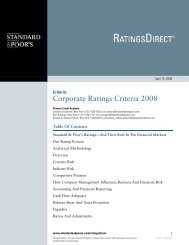European Infrastructure Finance Yearbook - Investing In Bonds ...
European Infrastructure Finance Yearbook - Investing In Bonds ...
European Infrastructure Finance Yearbook - Investing In Bonds ...
Create successful ePaper yourself
Turn your PDF publications into a flip-book with our unique Google optimized e-Paper software.
also be constrained by a project sponsor’s rating if<br />
the project is in a jurisdiction in which the<br />
sponsor’s insolvency may lead to the insolvency of<br />
the project, particularly if the sponsor is the sole<br />
owner of the project.<br />
During construction, often the project debt<br />
rating could be higher than the credit quality of<br />
the builder by credit enhancement and where<br />
there is an alternate builder available (see “Credit<br />
Enhancements (Liquidity Support) <strong>In</strong> Project<br />
<strong>Finance</strong> And PPP Transactions Reviewed,”<br />
published on RatingsDirect on March 30, 2007).<br />
Financial performance<br />
Standard & Poor’s analysis of a project’s financial<br />
strength focuses on three main attributes:<br />
• The ability of the project to generate<br />
sufficient cash on a consistent basis to pay<br />
its debt service obligations in full and on<br />
time;<br />
• The capital structure and in particular debt<br />
paydown structure; and<br />
• Liquidity.<br />
Projects must withstand numerous financial<br />
threats to their ability to generate revenues<br />
sufficient to cover operating and maintenance<br />
expenses, maintenance expenditures, taxes,<br />
insurance, and annual fixed charges of principal<br />
and interest, among other expenses. <strong>In</strong> addition,<br />
nonrecurring items must be planned for.<br />
Furthermore, some projects may also have to deal<br />
with external risk, such as interest rate and<br />
foreign currency volatility, inflation risk, liquidity<br />
risk, and funding risk. We factor into our credit<br />
evaluation the project’s plan to mitigate the<br />
potential effects on cash flow that could be<br />
caused by these external risks should they arise.<br />
Standard & Poor’s relies on debt-service<br />
coverage ratios (DSCRs) as the primary<br />
quantitative measure of a project’s financial credit<br />
strength. The DSCR is the cash-basis ratio of cash<br />
flow available for debt service (CFADS) to interest<br />
and mandatory principal obligations. CFADS is<br />
calculated strictly by taking cash revenues from<br />
operations only and subtracting cash operating<br />
expenses, cash taxes needed to maintain ongoing<br />
operations, and cash major maintenance costs,<br />
but not interest. As an operating cash-flow<br />
number, CFADS excludes any cash balances that a<br />
project could draw on to service debt, such as the<br />
debt-service reserve fund or maintenance reserve<br />
STANDARD & POOR’S EUROPEAN INFRASTRUCTURE FINANCE YEARBOOK<br />
PROJECT FINANCE/PUBLIC-PRIVATE PARTNERSHIPS<br />
fund. To the extent that a project has tax<br />
obligations, such as host-country income tax,<br />
withholding taxes on dividends, and interest paid<br />
overseas, etc., Standard & Poor’s treats these<br />
taxes as ongoing expenses needed to keep a<br />
project operating (see “Tax Effects on Debt<br />
Service Coverage Ratios,” published on<br />
RatingsDirect on July 27, 2000).<br />
<strong>In</strong> our analysis, we examine the financial<br />
performance of the project under base-case and<br />
numerous stress scenarios. We select our stress<br />
scenarios on a project-by-project basis, given that<br />
each project faces different risks. We avoid<br />
establishing minimum DSCRs for different rating<br />
levels because once again, every project has<br />
different economic and structural features.<br />
However, we do require that investment-grade<br />
projects have strong DSCRs--well above 1.0x-under<br />
typical market conditions that we think are<br />
probable, to reflect the single-asset nature of the<br />
business. Strong projects must show very stable<br />
financial performance under a wide range of<br />
stress scenarios. We also note that DSCRs for<br />
project with amortizing debt may not be<br />
directly comparable to DSCRs for a project using<br />
capital structures that involve a small annual<br />
mandatory principal repayment--usually around<br />
1%--coupled with a cash-flow sweep to further<br />
reduce principal balances.<br />
Capital structure.<br />
Standard & Poor’s considers a project’s capital<br />
structure as part of any rating analysis. A project<br />
usually combines high leverage with a limited<br />
asset life, so the project’s ability to repay large<br />
amounts of debt within the asset lifetime is a key<br />
analytical consideration and one of the primary<br />
differences between rating a project and a typical<br />
corporate entity. The same holds true for projects<br />
that derive their value from a concession, such as<br />
a toll road, without which the ‘project’ has no<br />
value; these concession-derived project financings<br />
likely have very long asset lives that extend well<br />
beyond the concession term, but nevertheless<br />
the project needs to repay debt before the<br />
concession expiration. Projects that rely on cash<br />
balances to fund final payments demonstrate<br />
weaker creditworthiness.<br />
Refinancing risk associated with bullet<br />
maturities typical of corporate or public<br />
financings are becoming more common in projectfinance<br />
transactions. Examples include Term Loan<br />
NOVEMBER 2007 ■ 99



